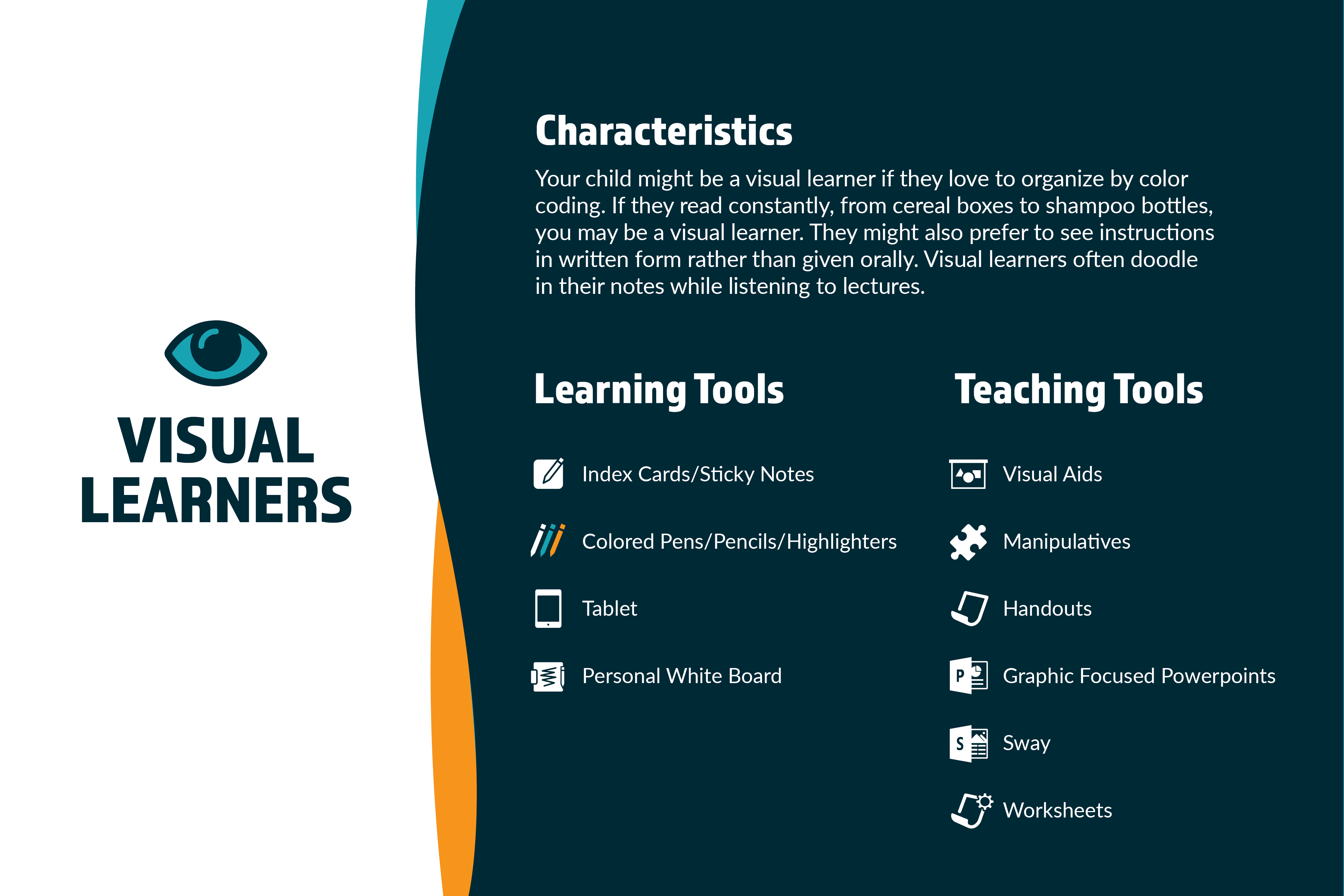
For a visual learner, a picture is worth ten-thousand words. Visual learners, or spatial learners, prefer to learn by seeing. The visual learning style is the first of Neil Fleming’s original VARK model, which includes visual, auditory, read/write, and kinesthetic learning types. We’ll give you several strategies to help visual learners make the most of their preferred learning style. Using visual aids in the classroom can benefit all students because every brain processes images faster than text and tends to store them as long-term memories. So all students can benefit from the promotion of a multisensory educational experience at home or in the classroom.
What is a visual learner?
A visual learner is someone who learns better from images, charts, and other visual aids. This does not mean that videos of real-life experiences will resonate with the visual style. Visual learners often prefer to use handouts, flashcards, and outlines to organize information. You might find them doodling in the margins of their notes or closing their eyes to try to visualize what they are hearing. Surprisingly, videos of tend to appeal more to kinesthetic learners than to visual learners.
How do visual learners learn?
Visual learners respond well to demonstrations, graphics, written words, and opportunities to sketch or draw concepts for themselves. They also love organization and spatial cues. They do not benefit as much from lectures, slides filled with words (they will read the slide but not listen to the instructor), class discussions, games, or visual chaos. That does not mean you should exclude these teaching strategies or avoid learning in situations that might use them. Every learner can be multi-modal and benefit from a variety of sensory experiences.
Visual learner characteristics
You might be a visual learner if you love to organize by color coding. Visual learners also tend to share characteristics with read/write learners because reading is typically a sight-based exercise. So, if you read constantly, from cereal boxes to shampoo bottles, you may be a visual learner. Because they remember what they have read, visual learners tend to be good spellers. They might also prefer to see instructions in written form rather than be given them orally. Visual learners often doodle in their notes while listening to lectures. Visual learners might not notice background noise, but they can be distracted by disorganization or movement in their peripheral vision. If you recognize any of these visual learning characteristics in your child, he probably has a visual learning preference.
What percentage of people are visual learners?
Up to 50% of people have a visual learning preference with most of those having a multimodal (more than one learning style) preference that includes visual learning. This data comes from several research articles that use the online VARK assessment, so the number might be lower if you consider the additional learning styles. Many online sources cite an article from the Social Science Research Network that states visual learners are 65% of the population, but that statistic has no research behind it.
About two thirds of people have multimodal learning styles, according VARK. When you consider the additional learning styles of logical, social, solitary and verbal, it is easy to imagine that everyone would be multimodal. You probably have a preference to learn in a group or alone in addition to your VARK preference. Some multimodal learners prefer a different mode in different contexts, while others will utilize all of their modes at once.
Visual learning style
The visual learning style is one of seven learning styles. Both visual and read/write learners often like to read. Visual learners and kinesthetic learners love watching demonstrations, although the kinesthetic learner may prefer to be more involved. Visual learning is most different from auditory learning, but it’s easy to combine visual and auditory in your lesson planning and reach both types of learners simultaneously. Logical, social and solitary learning can also overlap with visual learning in complementary ways.
Visual learning examples
Visual learners generally
- Keep things tidy and organized
- Prefer to read rather than listen to a story
- Excel at handwriting and spelling
- Stay focused on their work
- Make to-do lists and plans for the future
- Are more likely solitary learners rather than social but can benefit from group learning
- Study by looking at their notes rather than reading them aloud
- Sit close to the front of the classroom so they can see well
Study tips for visual learners
- Use colors to categorize information.
- Study early and often. The more times you see the information, the more you will retain.
- Make practice exams for yourself.
- Leave white space in your notes, so you can add to them later.
- Draw pictures.
- Make flashcards.
- Create graphs and charts.
- Make your own outlines.
- Rewrite key points from your notes.
 Using visuals in the classroom
Using visuals in the classroom
Visual aids are important in any classroom, even if you have no visual learners. The human brain processes images quickly. Visuals are engaging for everyone. A multisensory approach to teaching benefits most students, and there is evidence that children learn well this way even outside of their preferred learning style. Pictures and stories broaden our scope to include subjects we have not or may never encounter in real life. I recently told a young child that I play the clarinet. I could tell by her blank stare that she had no idea what I was talking about. So, I pulled out my phone and found a picture of a clarinet on the internet to show her. Now, the next time she hears the word clarinet, she will know what it is. I could have also found audio recordings so she would know what a clarinet sounds like.
Manipulatives also fall within the scope of visual aids, and will benefit kinesthetic learners as well, if you have some to share with students. I can remember learning fractions from a teacher using an overhead projector with transparent, colorful little squares. A visual learner might learn the parts of a flower from a diagram better than he would from an actual flower, because diagrams are more structured and predictable.
To use visual aids well, make sure they are large enough for everyone to see. All visual elements should be relevant and informative. Use only well-designed visuals. Infographics are very popular with visual learners. Use color appropriately. For example, in a bar chart, make the colors meaningful. Warm colors like red, orange, and yellow will make the important parts of a visual stand out and draw the eye’s focus there. Even without the use of color, visuals can take advantage of other preattentive attributes—attributes people notice automatically without thinking about—to draw focus. They include size, shape, orientation, and position, as well as color attributes like hue and intensity. Well-designed visuals that use preattentive attributes are attractive to visual learners and will work well for students with other learning styles.
Visual Teaching strategies
- Use visual aids in your teaching.
- Use manipulatives to reach both visual and kinesthetic learners.
- Give handouts for note-taking and let students doodle.
- Give students a small, personal whiteboard to use while you teach.
- PowerPoint can be helpful to visual learners, but only if you strategically include graphics. A slide with only words will not fully utilize the visual learning style.
- Sway is another interesting Microsoft presentation tool that is more interactive for solitary learning.
- Worksheets allow visual learners to practice and interact with the material. You get bonus points if the worksheet makes good use of color.
Activities for visual learners
- Use anchor charts in your classroom, and have students make them with you whenever possible. Anchor charts are colorful posters that include definitions and examples. They can be useful in various subjects, from geometry to science and even grammar and literature. Involving students in the creation of the anchor chart will enhance their understanding and ability to remember the information in it.
- Visual learners will enjoy color coding in any context. When learning parts of speech, you can use a different color for each one, and have students use those colors to mark practice sentences.
- Mind maps, flow charts, and various other types of diagrams help visual learners put the information in context. Because graphic representations can simplify complex ideas, diagrams will likely help students with other learning styles as well.
Visual learning tools for students
Visual learners will appreciate having the following tools handy for learning:
- Index Cards or sticky notes. Put a key word on each card and the definition on the back. Use them as flashcards to help memorize facts. Alternatively, arrange the terms into a mind map to see how they best fit together. Use different colored sticky notes to group items into categories. Arrange events in chronological order.
- Colored pens, pencils, highlighters. Visual learners love to use color to organize their thoughts. Look for waterproof, acid-free art or scrapbooking pens for long-lasting visuals.
- Paper and notebooks. Visual learners like to write, take notes, and doodle. They will need plenty of paper. Encourage them to draw their own anchor charts to help them remember key facts.
- Personal white board. When I was a student, I used a rewritable tablet called a magic slate to memorize proofs in math class. A personal sized white board or tablet would work well for the modern student. The act of writing information out can help both visual and read/write learners.
You may be tempted to incorporate more high-tech tools for visual learning, but keep in mind that for visual learning it is often the action of seeing the words take shape as the student writes them that is most beneficial. In other cases, it is the action of drawing a graph or giving shape to an idea that helps them retain information. Typing information speeds up the process, but it also creates distance between the learner and the information.
Benefits of Visual Learning Methods
Visual learners benefit from the speed with which our brains process images. Charts and graphics often convey complex information in an easy-to-digest manner. Teaching with visual aids can remove language barriers in a multi-cultural classroom. For these reasons, including visual elements in your teaching will benefit most students, not just those with a visual learning style.
• • • • •
Valerie is a wife and a mother to a very busy toddler. In her free time she enjoys reading all kinds of books. She earned a B.S. in Biology from Bob Jones University, minoring in Mathematics, and a Ph.D. in Molecular Genetics from Ohio State University. Valerie has 15 years of experience working in research laboratories and has coauthored 8 original research articles. She has also taught several classes and laboratories at the high school and college levels. She currently works as a Data Analyst and a freelance writer.
Leave a Reply